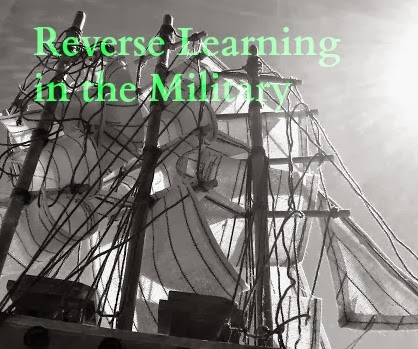The concept of reverse teaching has been around for nearly
200 years. In practice it has led to both strong and poor performance of
students. This is often dependent on the motivation of the student and whether
or not they are actively reviewing materials and making connections between
that information. A paper by Maria Constantinescu (2013) discussed how reverse teaching
works with e-platforms in the military.
Reverse teaching is a process whereby the teacher provides
the necessary materials and tools for students to understand theoretical
concepts. Students study on their own time and then come back to class to show
what they know. It is based off of a model implemented by the 1817 Colonel
Sylvanus Thayer at West Point who is known as “Father of the Military Academy”.
The same process also occurs in an online environment
whereby the instructor provides the right materials and students use these
materials to study the concepts. The class is used as a place where they can
display the material, gain new connections of concepts, and share
understandings. Both individual and group activities occur to help foster this
learning.
The author discusses the importance of e-learning platforms
in developing the right learning environment. As the classroom environment is
the place in which students come back to show their mastery it must be designed
well to allow students to engage in these single and group practices to the
fullest extent possible. Without a strong classroom design the student may not
engage the learning process or show what they have learned.
Likewise, the author did well bringing up a problem with
assessment. It appears that the platform she used was lacking a formal
assessment process. Each conceptual module requires some form of assessment which
ensures the students have learned what they need before moving onto the next
module. Without this assessment the student would have difficulty constructing
even more difficult concepts later in the class.
The use of papers that incorporates critical thinking
analysis and formalizes a greater picture is important. This is where students
show the teacher what they have learned, how they understand the material, and
how they use it to solve a particular problem. Teachers act as guides and find
holes in their understanding and fill them with appropriate materials and
information to create greater bridges.
The advantage of such programs in the military is that it
affords greater flexibility and creativity with learning. Each person
constructs meanings through the offered material and their past experiences to
come up with a bigger understanding. This affords them the opportunity to own
the information and creates greater motivation for practical implementation.
The biggest detractor is the willingness of the student to expend effort and
time in the learning process. Student motivation is a difficult problem that
many military academies and colleges have suffered for decades.
Comment: The use
of reverse teaching is related to reverse learning. When focused on a particular problem unwanted
mental connections are lessened while useful connections are strengthened. This
is the core of learning and unlearning. As students construct concepts in their
own way each of the neural connections should lead to proper conclusions
offered within the class. This is a formalization of a larger concept based
within the many smaller understandings offered through materials. To implement
strong reverse teaching means that greater care over the types of materials
offered are necessary to ensure they lead to a greater conclusion. If the materials are not aligned well it could
create confusion among students.
Constantinescu, M. (2013). Considerations on reversed
teaching in the military education system. eLearning
& Software for Education, 2.

No comments:
Post a Comment